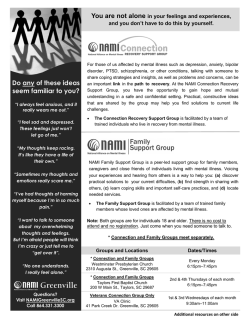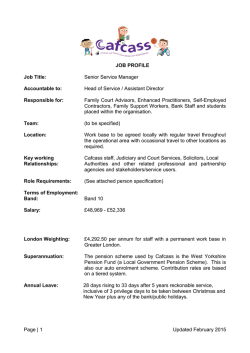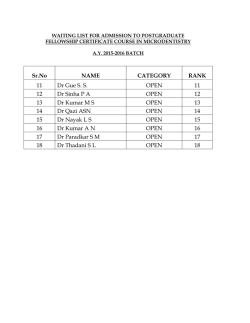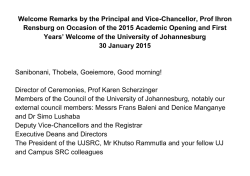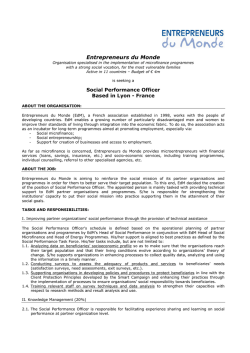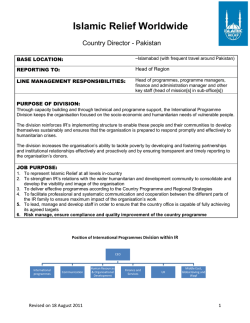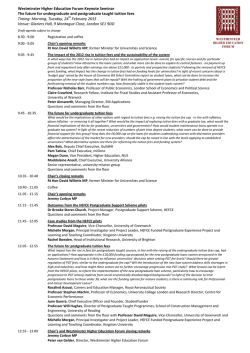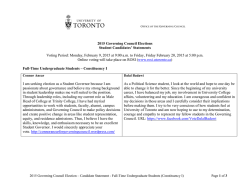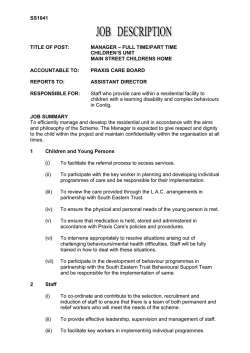
Laying the foundation
A FUTURE IN GENERAL PRACTICE 23 SECOND SESSION OPENING REMARKS DrW. V. Howells O.B.E., M.A., M.B., B.Chir., M.R.C.S., L.R.C.P., F.R.C.G.P. (Chiairmiiani) IT is indeed a privilege to be here. It is due to Dr John Hunt and a small band of people that the College started and has done so well that now after 16 years we have about 8,000 members and associates and we are a Royal College. Initial enthusiasm has enabled us to do a great deal but we are reaching a plateau where it is necessary to think again which way we are going. The aim of the College is to improve general practice. Not many of you will remember the Collins report but it showed how bad some general practice was. We can feel happy if we have helped with the improvements by emphasis on training, education, and research. Although the College has its headquarters in London, it has all the time placed emphasis on having regional faculties. In Wales we now have a South-east Faculty based on Cardiff, a South-west Faculty based on Swansea, and a North Wales Faculty associated with Liverpool and Merseyside. The Welsh Council will co-ordinate all three faculties and has pronmoted special interest groups where people of like mind and special interests can meet and talk things over. I am sure we will benefit greatly from the results of this symposium. Laying the foundation-teaching students Dr P. S. Byrne, O.B.E., M.B., Ch.B., F.R.C.G.P. (Director, General Practice Teaching and Research, University of Manchester) Cascellius extracts an aching tooth, Hyginus removes the hairs that hurt the eyes, Hermes is a very Podalirius at the repair of hernia; but tell me Gallus, where is he that map help my harrassed person-Martial, Epigrams, X, No. 6. (Circa A.D. 40). T HIS timeless cri-de-coeur is still more powerfully voiced by our present populations. 1 It highlights the ancient continuing distinction between specialist and generalist and yet it emphasizes the special attributes required of the latter. It must be kept in mind in creating our programmes for undergraduates in this presently unique and exciting situation. The teaching of undergraduates will always be the responsibility of a university and vested in one of its departments. In the case of general practice this will normally be the university department of general practice. The word 'normally' is not used ill-advisedly, for at least ten schools in Britain have at the moment departments in various stages of gestation. Such infants vary in the evidence they betray of planned parenthood, while the parental patterns show social medicine as particularly fertile. Views on departments vary too. Some regard them as an administrative unit to organize cosy preceptorship schemes. Others regard their function as the provision of a model practice in which teaching and some gentle research may take place. I AFurunIN GENERAL i?RAcncE believe that the university department should be responsible for undergraduate teaching 24 and for planning, implementation, and supervision of postgraduate training, and that it should further play an increasing role in continuing education. It will have the widest possibilities for research in clinical, operational, epidemiological, social and educational fields. In this latter area will be the so important task of the evaluation of teaching in each of the three main periods. While conceptually and administratively it is convenient-even necessary-to consider and plan the three phases separately, it must ever be remembered that they represent a continuum and should be planned as such. Our own department-now an independent department of the Faculty of Medicine-is in what I believe to be the unique situation in British medicine of being formally charged by the university with the duty of creating and fulfilling a substantial undergraduate programme and at the same time devising regional postgraduate training programmes for our anticipated output of prospective general practitioners. It will be so much easier for us therefore to devise the latter programmes, knowing what we have done in the former. Implicit in our postgraduate scheme is a major research project of evaluation. We intend also to apply similar methods of evaluation to our undergraduate programmes,,which are yet to be devised. Here of course is the rub. There is no blue-print for the foundations we are to lay and there are no textbooks-nor can there be yet-for I am certain that textbooks should transmit and illuminate the products of experience; without this they are meanI ingless. It seemed that a useful way of high-lighting the present situation would be to present to you my own departmental paper. This is the base on which we are building our undergraduate programmes, while they in their turn will condition the requirements of our postgraduate training. The undergraduate phase is indeed a foundation. All our teaching and training for general practice is calculated to produce a general practitioner. In this educational exercise we must define him and his r6le. We may then define and expand those matters to be taught, their situations, timing and the methods to be used. Any who are planning postgraduate training must do some sums. These basic definitions will determine what is to be taught. That which has been taught in the undergraduate period will be subtracted from the whole. The remainder is the substance of postgraduate training. Detailed knowledge of the undergraduate curricula of the several medical schools is essential to those planning postgraduate training. This knowledge should be supplemented by an initial assessment of the trainee at the commencement of his course. I have not trespassed into the fields of Drs Swift and McKnight, but it seemed that as the first speaker in this series it was necessary to demonstrate the place and influence of the undergraduate period as I see it. Here then is our working paper, which does not answer questions but merely defines them. We will tell you our first answers in one year and show them in practice in 18 months. Here is our definition of the general practitioner: The general practitioner is a doctor who provides personal primary and continuing care to individuals and families. He may consult with or attend his patients in their homes, in his consulting room or in hospital. He accepts the responsibility for the initial decision on any problems his patient may present. He will consult with other specialists when he considers it to be appropriate. He will normally work in a group with other practitioners from premises built or modified for their purposes, in co-operation with paramedical colleagues, secretarial staff and all necessary equipment. He will thus need to practise teamwork and delegation. He will usually have a special interest in another branch of medicine. His diagnoses will be composed in biological, i.e. physical and psychological, and social terms. He A FUTURE IN GENERAL PRACTICE 25 will decide when to intervene for his patient to offer treatment, health education or preventive measures. He will be skilled in managing his patients in health or in illness. The contents of our programmes must be developed while considering the overall purposes of a medical school, recognition of our duty to assist in promoting the philosophy of our own school, a definition of the determinant features of general practice, and the logistics of our own situation. The overall aims of a medical school are two-fold: A. To produce and sustain doctors to give medical care to people. B. To advance medical knowledge. These overall aims must be further considered. They have been discussed by the General Medical Council in its Recommendations on basic medical education (1967) where the doctor referred to in 'A' is indicated as a basic doctor who will require postgraduate training for whatever branch of medicine he will pursue. Again in broad terms this basic doctor must be equipped with knowledge and skills, thus: 1. The nature of man in biological and social terms 2. The meaning and nature of illness 3. The skills and techniques of eliciting and interpreting information and (lata 4. The range and possibilities of medicine and medical services 5. He should also have or be inculcated with certain attitudes. 1. The nature of man in biological and social terms In our new curriculum this is the major theme of the pre-clinical period. It seems proper that the student should be informed of normal man before he commences to study man in illness. Hence the undergraduate will learn during his course of: a. Human development throughout the seven ages of man in physical, emotional, intellectual terms b. The range of normal in the same areas c. Human behavioural patterns d. The structure of society. 2. The meaning and nature of illness Based on the premises of 1, the old disease concept of illness is no longer appropriate, except in crises. The equation, diagnosis = illness = disease, must be replaced by the recognition and understanding of illness as a multifactorial condition described in clinico- and sociopathological terms. Diagnoses, which are often only assessments but always the bases on which decisions are made, must therefore also be stated in biological and social terms. It will be made clear that the biological terms include the clinical, i.e. physical, organic and psychological components of illness. The natural history of disease must be taught and this will include studies of epidemiology in its modern sense and of statistics. 3. The skills and techniques of eliciting and interpreting information and data. Perhaps first in the skills is that of communication. Communication with patients includes the skills of history-taking, of counselling or advising, and of persuasion. There are necessary skills in communication and relationships with other doctors, with paramedical colleagues, institutions and other bodies. These will include skills in referral, in advising, in personal relationships, in the roles of authority or subordination, in delegation and in the team-work on which so much of the practice of modern medicine depends. The next skill is in physical examination which may be systematic, regional, local, or complete, involving the use of the doctor's five senses. It must be accompanied by skill in the planned use of investigations which implies economy and precision. The use of these two major skills will have presented the doctor with the necessary information on which he may then use the important skill of problem-solving. The 26 26 A FUTURE AFTR IN GENERAL PRACTICE NGNRLPATC definition of the problem will require, in addition, factual recall. This basic knowledge will also indicate the areas in which the skills of information gathering are to be employed. The solutions to problems will be expressed in decisions, in diagnoses and in plans of management. These are the fundamental basic skills of medicine. The wide range of special skills, of techniques and procedures appropriate to the several branches of medicine should be in part demonstrated but need not all be taught to undergraduates. 4. The range and possibilites of medicine and the medical services A wide exposure to different branches of medicine in the teaching hospital, in district hospitals, in general practice, in public health, industrial medicine and in the service departments is necessary. Instruction in and demonstrations of the organization and functioning of the medical care services are also required. 5. His undergraduate course should surely encourage in the undergraduate favourable and salient attitudes to enquiry and to personal continuing education. His attitude towards the patient as a whole person should be similarly qualified. He should be taught by example to be kind and compassionate. He should learn and accept his own limitations and those of medicine. Now in educational terms we may re-state these premises. The overall aims of the medical school should be to: 1. Produce and sustain doctors to give medical care 2. Advance medical knowledge. The special aims are those which have been listed under I and 5, with the brief expansions. The area aims will need to be defined severally by the departments or units of the medical school involved in teaching. Each unit must subscribe to the overall aims and yet in so doing indicate by its objectives those areas and the extent in each where this subscription will be made. In the Department of General Practice we must define first our own area aims and then our objectives. It will be at this latter stage that we are entitled to create our teaching programmes. We know that there will be 160 students in each year until 1973 when there will be 200, and even more over the following few years. We understand that the teaching time and situations which the curriculum presents to us are as follows: INTRODUCTORY CLINICAL COURSE. One session of 21 hours. 1. First clinical year. A period of 24 days between 1 December 1970 and 30 June 1971 for groups of about 18 students in each period. 2. Second clinical year. A period of a fortnight in this year which will be a detachment to a selected practice from a four month's residence in a district general hospital. 3. An elective period. Of 2 to 3 months between the second and third (or final) clinical years. The number of students who may choose an elective in the department is not known, but the department will create its own list of programmes of electives from which the student may make his choice. 4. Final year. Elective tutorials which will almost certainly need to be held both at the Royal Infirmary and at Withington. Our defined area aims must be translated into objectives which relate to this logistical situation. At the present time it would appear that the introductory clinical course A FUTURE IN GENERAL PRACTICE 27 is not completely agreed and decisions may be, for the moment, deferred. We may therefore consider the clinical years. The period of time provided means that for the first time in British, or other, medicine, the first clinical experience for some undergraduates will be in the department of general practice. We have no helpful precedents. Moreover, we will stand or fall on the success of the relevance and standards of our programmes. Whatever special pleading we may devise for students or faculty will have no weight after the first year or two of undergraduates have passed through our hands. We must do our best to ensure that we get our premises right first time. We will always have to develop our methods in the light of growing experience and the changes in medicine and the medical curriculum. Essentially, we must determine the quite fundamental question: What is there special in general practice which may at this period in their career be taught to students? Our greatest skills lie in communication, problem-solving, and decision-making. It is these skills, particularly that of communicationi, allied to our broad-based knowledge, which distinguish us from the newly-qualified or the serried ranks of specialists. Our major fields of knowledge lie in the general medicines, human development and behaviour, in epidemiology. We properly and openly use probability diagnosis, we seek to detect early departure from the individual norm, and we are skilled in synthesizing and integrating the management of a patient's illness. It is suggested that we may define our area aims as follows: 1. To demonstrate and teach skills in communication, in the collection of information and data relating to patients. 2. To demonstrate and teach skills in decision-making and problem-solving. This will include early and probability diagnosis. 3. To demonstrate and teach personal, continuing family care, considering always the individual in the family in the community, and the individual being always regarded holistically in biological and social terms. 4. To demonstrate the nature of illness. 5. To contribute to the overall aims of the medical school as previously defined. Before going on to define our objectives, two more points are to be considered. The first is that we need not attempt, even if we could, to compete with hospital teaching in the time we may allow individual students with individual patients. Our patients are neither captive in bed nor so immediately dependent on our services. We must not reach a situation which, in this context, means the continuing desire of the patients for our services. The second is of equal importance, namely that because first-class service is our fundamental purpose we must arrange our teaching and research accordingly within the possibilities afforded by time, space and staffing. Let us now consider the three or four weeks teaching in the department in the first clinical year. The commonest teaching situations for general practice are in the old apprenticeship style of person to person. Although this is the least represented in the literature of education, there seems to be agreement that given a good teacher this is the optimum situation. Perhaps the next most common situation is the small group, and last of all the didactic lecture which has been recently so viciously analysed by McLeish that I blush to appear before you this afternoon. Of group teaching much is known and we must make much use of it. Our situation is conditioned in part by what is at the moment a time-table rather than a curriculum, for it is the substance of content based on a philosophy and fitted into a time-table which composes a curriculum. The situation is further conditioned by the numbers of students and the number of staff available as 28 A FUI'URE IN GENERAL PRAC-lICE well as by their service load. Nine students each morning and only six staff mean that person-to-person teaching is not possible for all on each occasion. Nor is the consultation of general practice suitable for group teaching except with a few willing and prepared patients. We must therefore use not only the group situation but also some newer audiovisual means. I have suggested that our greatest skill lies in communication in its various forms and in problem-solving. We may teach these skills in two ways at least. First in the person-to-person pragmatic situation of the normal patient consultation. Here the development of a history can be shown repeatedly and the methods of obtaining further information about the patient demonstrated. It is then possible to define the patient's problems and then to propose solutions. To assist us in this method we have begun to adopt the recording methods of Lawrence Weed, now at Burlington, Vermont. He has written much about clinical recording and I commend both his book and his methods to you (Medical records, medical education and patient care). The front sheet in each patient's record is headed 'Patient's problems' across two columns ACTIVE and RESOLVED, with a space for the date. Clinical notes are made against the problem index number under the headings SUBJECTIVE and OBJECTIVE, and are followed by PLAN. This is the salutary part of the exercise, where the plan for the treatment and management of the patient's problem is written down. You are forced to consider the patient holistically as all his current problems, physical, psychological and social, are clear before you. Laboratory findings and x-ray reports are similarly filed and flow sheets kept. The second situation is achieved by scripting and filming or videotaping consultations. This is in one way better than the live situation because specific points may be readily developed. A patient may be used live in an artificial situation, providing there has been rehearsal, or amateur actors and actresses may serve better. A combination of these two methods should teach the bones of communication or problem definition and solving. Involved also in the teaching will be the nurse, the health visitor and the social worker. We are preparing an index of suitable patients for teaching and are experimenting with the creation of teaching tapes. I have already made one long and six short programmes. In this extended period we will further seek to demonstrate the nature and natural history of illness. Simple series of patients suffering from bronchitis, congestive heart failure or otitis media in their varying stages are examples, while the recording system always ensures the fundamental holistic view. Teaching in the second and third clinical years must have different emphases. By this time the student has a greater store of service knowledge. He is more competent to identify and hence to begin to solve problems. In the final year in the elective tutorials, we present a brief history of a real patient and then develop information-gathering and problem-solving by Socratic discussion with the class, which last term averaged about twenty-five. In the second clinical year, the students will be detached into our peripheral teaching practices. The emphases on teaching there, which we have not yet altered, are laid out in my Gale Memorial Lecture (Byrne 1969). Our menu of electives includes a variety of projects occupying differing periods of time in our own department. We are arranging other programmes in other British schools on a knock-for-knock basis, and I have laid on several programmes in Nigeria, USA, Canada and Europe. At my fifth ten-session course for general-practice teachers, we were assisted by A FUTURE IN GENERAL PRACTACE 29 an able educationist who teaches in the Manchester Business School. The techniques of the solution of management problems are in many ways similar to those of patients' problems. In each case information has to be gathered about people, various technologies and sciences are involved and the identification of the problem is fundamental. The business schools have much to teach the universities about teaching. We on our part should be like the Chinese in their capacity to take the theories and concepts of others and mould them to their own design and needs. Laying the foundations for undergraduate teaching means not only preparing syllabuses and programmes but preparing teachers. We, the latest recruits to professional medical teaching, are not yet confined by the inertia of establishment. Not only must we learn our trade but much of what we do is in the nature of experiment. We should be eager to learn our trade, glad to experiment prospectively and to evaluate the results. Then we will have laid the firmest of foundations to produce him who will help the harassed person. REFERENCES 1. Harris, C. M. (1968). General practice teaching of undergraduates in British medical schools. Reports from general practice, No. 11. London. Royal College of General Practitioners. 2. Byrne, P. S. (1968). The passing of the eight train. Journal of the Royal College of General Practitioners. 15, 409. 3. McLeish, John. (1968). The lecture method. Cambridge Monographs on Teaching Methods, No. 1. Cambridge Institute of Education. 4. Weed, Lawrence L. Medical records, medical education and patient care. School of Medicine, Western Reserve University, Cleveland, Ohio, U.S.A. 5. Byrne, P. S. (1969). Journal of the Royal College of General Practitioners. 17, 69. Special training for general practice Dr George Swift, B.M., B.Ch., F.R.C.G.P. (Chairman of Council Royal College of General Practitioners) Dr Swift presented his paper. Maintaining and testing standards Dr John McKnight, M.B., B.Ch., B.A.O., M.R.C.G.P. (Director, Department of Postgraduate Medical Education) J AM a little worried about the title of my paper because if we merely set out to maintain anything in this world I feel sure that we are bound to fail. Those of you who do any snipe shooting will know that the basic rule in that sport is to aim high. I am a great believer in aiming high. And therefore I suggest that we should consider how to improve
© Copyright 2026
